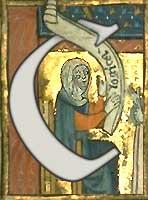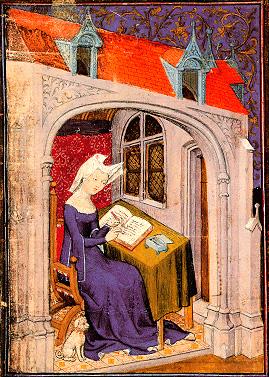 ENGL 252: Great Books II:
Medieval and Renaissance Literature
ENGL 252: Great Books II:
Medieval and Renaissance Literature
Dr. Debora B. Schwartz
Calendar, Winter, 2016
| Week: | 1 | 2 | 3 | 4 | 5 | 6 | 7 | 8 | 9 | 10 |
 ENGL 252: Great Books II:
Medieval and Renaissance Literature ENGL 252: Great Books II:
Medieval and Renaissance Literature
Dr. Debora B. Schwartz Calendar, Winter, 2016
|
In addition to the required textbooks for this class, some required readings are found in .HTML files on my website or have been placed on "electronic reserve" as .PDF files on PolyLearn. To access online readings, click on the links provided and print out the files. To access e-reserve readings, log in at MyCalpoly, go to "My Courses" and select "ENGL 252" from the classes you are taking. Click on the PolyLearn link and go to the Electronic Reserves folder to download, read and/or print the file using Acrobat Reader. Please note that ALL required electronically accessed readings should be PRINTED OUT and BROUGHT WITH YOU TO CLASS.
| Topic and Readings | |
| Day 1 | Introduction to ENGL 252 and background lecture. Topic: Translatio studii et imperii: passing the twin torches of cultural or literary authority and of political legitimacy from one civilization to another. [NOTE: instead of printing out this webpage, print the text-only version on E-reserve in PolyLearn under the title Translatio.pdf ] |
| Day 2 | Topic: Medieval
Prologues and Translatio.
Readings
are to be completed prior to our class meeting; don't
forget to bring print-outs / textbooks with you to class!
Required background readings:
Also recommended (but not required):
|
| Topic and Readings | |
| Day 1 | Required background readings:
|
| Day 2 | Required Background readings:
Text info:
|
| Topic and Readings | |
| Day 1 |
Required Background readings:
Required Primary Reading: Chrétien de Troyes, The Knight of the Cart (Arthurian Romances, 207-94).Text info:
|
| Day 2 |
First
hour: wrap-up discussion of the Knight of the Cart.
Second hour: NEW READING: Chrétien de Troyes's Cligés (Arthurian Romances, pp. 123-205). Required Background Reading:
|
| Topic and Readings | |
| Day 1 |
First
hour: wrap-up discussion of Chrétien de Troyes's Cligés
(Arthurian Romances, pp. 123-154); the medieval
manuscript tradition of The Knight of the
Cart (which you can explore via the Princeton
University Charrette
Project).
Second hour: Introduction to Heldris of Cornwall, The Romance of Silence (NOTE: The new readings listed below will be covered on both Midterm Exam 1 and on today's reading quiz!) Required Background readings:
|
| Day 2 |
Midterm Exam 1 (covers ALL MATERIAL ASSIGNED THROUGH TUESDAY 1/26, including the background information on and first section of The Romance of Silence (Prologue and "Prequel" story of Silence's parents, pp. 3-79). |
| Topic and Readings | |
| Day 1 |
Heldris of
Cornwall's The Romance of Silence;
complete reading of whole text before class
meeting.
Carefully Review the Following Required Background Readings:
|
| Day 2 |
First hour: As needed, complete
discussion of The Romance
of Silence
Second hour: Backgrounds to Geoffrey Chaucer and The Canterbury Tales; the General Prologue to The Canterbury Tales. Required Background readings: Required Primary readings:
|
| Topic and Readings | |
| Day 1 |
Chaucer, the General
Prologue to The Canterbury Tales.
Review Background Readings assigned for last class meeting. Required Primary Reading:
REMEMBER: YOU SHOULD NOT SUBSTITUTE ANOTHER EDITION/TRANSLATION for the Penguin Classics version ordered for this class!
|
| Day 2 |
As necessary, complete discussion of Chaucer's General Prologue to The Canterbury Tales. 2nd Hour: New Reading: Chaucer's The Knight's Tale Required Background Readings:
|
| Topic and Readings | |
| Day 1 |
NO CLASS (Monday classes meet) |
| Day 2 |
Chaucer, The Knight's
Tale and The
Miller's Tale.
Required Background Readings:
|
LOOKING AHEAD: before class on Tuesday, March 1,
you are required to have screened a video
version
of Shakespeare's A Midsummer Night's Dream AND
to have posted a short written response to it in the PolyLearn
Discussion Forum for the film you have selected. You
may choose any of the filmed
versions
listed on the class website (all of which are on
Reserve for ENGL 252 in the Kennedy Library) except the
1982 Joseph Papp / Public Theater
version that will be screened in class. NOTE:
prior to screening the film, it is recommended that you read the
online Synopsis
of A Midsummer Night's Dream.
| Topic and Readings | |
| Day 1 |
As needed, wrap-up discussion of The
Knight's Tale and The Miller's Tale. New
reading: The Wife of Bath's
Prologue and Tale. In The
Canterbury Tales, tr. Nevill Coghill (Penguin
Classics), pp. 258-92.
DO NOT SUBSTITUTE ANOTHER EDITION/TRANSLATION; you MUST use the Penguin Classics version ordered for this class! Background: review the online readings "Courtly Love" and "Translatio" Text info: Geoffrey Chaucer lived ca. 1343-1400. All of our Chaucer readings were originally written in English rhyming couplets in iambic pentameter (ten-syllable lines with an alternating pattern of unstressed and stressed syllables). An "iamb" is a two-syllable unit in which an unstressed syllable is followed by a stressed one; five such two-syllable units form an iambic pentameter line with the stress pattern "da DUM, da DUM, da DUM, da DUM, da DUM."
|
| Day 2 |
Midterm
Exam
2 REMINDER: before class on Tuesday, March 1, you are required to have screened a video version of Shakespeare's A Midsummer Night's Dream AND to have posted a short written response to it in the PolyLearn Discussion Forum for the film you have selected. You may choose any of the filmed versions listed on the class website (all of which are on Reserve for ENGL 252 in the Kennedy Library) except the 1982 Joseph Papp / Public Theater version that will be screened in class. NOTE: prior to screening the film, it is recommended that you read the online Synopsis of A Midsummer Night's Dream. |
| Topic and Readings | |
| Day 1 | REMINDER: before today's
class, you are required to have screened a video
version
of Shakespeare's A Midsummer Night's Dream
AND to have posted a short written
response to it in the PolyLearn Discussion Forum
for the film you have selected. You may choose any
of the filmed
versions
listed on the class website (all of which are on Reserve
for ENGL 252 in the Kennedy Library) except the
1982 Joseph Papp /
Public Theater version that will be screened in
class. NOTE: prior to screening the film, it
is recommended that you read the online Synopsis
of
A Midsummer Night's Dream. First hour: Background Readings for Shakespeare's A Midsummer Night's Dream:
In addition to reading the assigned text, you are required to watch a filmed version of the play chosen from those listed on the class website, but please note that watching a performance (or reading the synopsis) ALONE -- without also READING THE TEXT -- will NOT be sufficient to score well on quizzes or on the final exam! Required Background Readings:
|
| Day 2 | Shakespeare, A Midsummer
Night's Dream, Acts 3-5.
Lecture will refer to the text as well as selected scenes from several filmed versions of the play which will be screened in class (and are on Reserve for ENGL 252 / ENGL 339 in the Kennedy Library). In-Class video screening: start of the 1982 Joseph Papp / Public Theater A Midsummer Night's Dream (also possibility of additional clips from other version of the play).
|
| Topic and Readings | |
| Day 1 | In-Class video screening: more of the 1982 Joseph Papp / Public
Theater A Midsummer Night's Dream (also
possibility of additional clips from other version of the
play).
|
| Day 2 | As needed, in-Class video screening: end of the
1982 Joseph Papp /
Public Theater A Midsummer Night's Dream (also
possibility of additional clips from other version of the
play).
|
Final Exam Thursday,
March 17, from 1:10 - 4:00 PM. You MUST take Final Exam at
scheduled time!! Please keep the exam date in mind as you
plan your end-of-quarter travel.
Contents of this and all linked pages Copyright
Debora B. Schwartz, 1995-2016
|
 |